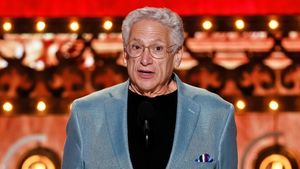In November of last year, The Advocate published an essay by filmmaker Robert Camina concluding that, after years of extensive research for his documentary Upstairs Inferno, a man named Larry Norman Frost was one of the unidentified victims of a 46-year-old hate crime, the UpStairs Lounge fire. Shortly after the article was published, The Advocate received a statement from Robert Fieseler and Clayton Delery, who have both written books on the tragedy, refuting that identification. Here is their essay.
Last year, The Advocate published a story by filmmaker Robert Camina in which he claims to have identified one of the three unidentified victims of the 1973 Up Stairs Lounge fire, which claimed the lives of 32 people and was, until the 2016 massacre at Pulse, the worst mass killing of gay Americans in U.S. history. "It is time to officially acknowledge Larry Norman Frost," Camina writes, "as a victim of the Up Stairs Lounge arson." Any claim on the Up Stairs Lounge that appears in The Advocate, a publication of record in which many of the original Up Stairs Lounge stories appeared in 1973, carries additional weight.
As authors of a pair of deeply researched histories about the fire and its aftermath, we are intimately familiar with the case for potential victims and their complexities. Additionally, one author of this response, Clayton Delery, appeared as an expert source in Upstairs Inferno, Camina's 2015 documentary film on the tragedy. In June of 2018, Robert Camina told Up Stairs Lounge historians Clayton Delery and Frank Perez as well as Skip Bailey, nephew of UpStairs Lounge victim Ferris LeBlanc, that he believed he possessed sufficient evidence to announce the name of a previously unidentified victim in the near future. Thus, we were quite eager to see what Camina had discovered. Upon reading the Advocate story, however, we quickly saw that his claim was deceptive. In calling for an official revision of the record, he has, in our opinion, overstepped the evidence and mismanaged an inquiry into one of the most sensitive matters in Up Stairs Lounge history.
The fire, the deadliest in New Orleans' history, killed three people whose remains were burned beyond recognition. They were buried in a pauper's field on the outskirts of the city without grave markers. Since the advent of Up Stairs Lounge scholarship, historians have endeavored to help identify them in the hopes of restoring some measure of dignity to their memories. Several candidates, including Larry Norman Frost, have been considered, but evidence has not been sufficient to satisfy the Orleans Parish Coroner, an official with the legal power to declare a death and its cause. In his story, Camina claims to have performed enough "due diligence" to announce Frost as a fire victim through the "discovery of additional substantive documents," so we were puzzled when we saw that the documents he cited for substantiation have been known to Up Stairs Lounge scholars for a decade or more.
Here are facts on Larry Norman Frost known by scholars: Eyewitness testimony puts Frost in the bar on the night of the fire, and he was not known to have been seen afterward. His name was reported to police as being among the possible dead. Investigators had contact information for Frost's mother, and Frost was, at one point, listed as tentatively identified by authorities. A local newspaper called the Vieux Carre Courier named him as a potential victim in one article. But, bottom line, investigators never felt that they had enough evidence to confirm Frost as dead at the UpStairs Lounge.
That's where the story stood until this recent declaration. So what new evidence has Camina provided? Through family testimony, he presents a complex oral history of how Frost's relatives coped with the absence of a loved one, some believing Frost to have died in the fire, and at least one believing Frost to perhaps still be alive. While that is a compelling story, and provides viable leads that might point to a more concrete discovery, it adds no new forensic evidence to support Frost's identification. It's worth noting that none of the surviving family members are quite certain when or from whom they received news of Frost's death, though they are all fairly certain that nobody heard it from a police investigator or public official.
Camina does provide one new physical detail: the possible presence of metal plates in Frost's skull as the result of an auto accident some years before. That detail, in itself, could be significant if it can be corroborated elsewhere. The problem is that none of the autopsy reports mention one of the bodies having metal plates in the skull.
Meanwhile, Camina fails to grapple with existing evidence that contradicts his narrative. A typewritten document in the New Orleans Police Department docket, which holds the official police report and supplemental files, presents a list of names and forensic clues that both police and the coroner used to help identify those who died at the UpStairs Lounge. This list contains the names of many people known to have died in the fire and also the names of people, like Larry Norman Frost, who were at one point suspected dead. This document notes that Frost had "three teeth missing, back left" and "may have glass left eye." These important, potentially identifying details are uncorroborated by any of the autopsies. We repeat for emphasis: No bodies in the morgue were found to possess these attributes.
Curiously, another mention of Frost having a "glass left eye" did circulate at that time. New Orleans journalist Bill Rushton, who listed Frost as a potential victim in the 1973 article for the Vieux Carre Courier, wrote the words "glass left eye" in his reporting notes on Frost [pictured below]. Clearly, one constituency had informed other, as both police and a member of the press considered it worthy of note.

Bill Rushton, Up Stairs Lounge fire notes, page 3, June 28, 1973 - December 18, 1974, Bill Rushton papers, Vieux Carre Courier Collection, Earl K. Long Library, University of New Orleans.
Camina's exclusion of "three teeth missing, back left" as an identifying detail is particularly troubling because, prior to reliable DNA testing, dental records were the surest and most reliable means of identifying a body. Several of the fire victims are known to have been identified through dental records, and the thirty-two autopsy reports contain many references to who had missing teeth, plates or dentures, because all were invaluable clues. Yet, none of the unidentified bodies was described as having missing teeth in the autopsies. Camina never mentions this discrepancy.
Although it's unclear if Camina knew of Rushton's reporting notes, it's incontestable that he knew of the typewritten document because he cites it elsewhere in his story when confirming that police had the correct contact information for Frost's mother. Such a confirmation, performed by Frost's sister Nancy Spence, adds credibility to the information it appears with, as it shows that authorities had the capability to call the family home when investigating. Camina included several images from Up Stairs Lounge archives in his article, but it's all too convenient that he chose not to include an image of this document, which we present here.

NOPD General Case Report Supplemental File, page 3, June 1973 - August 1973, Up Stairs Lounge Records, Louisiana Division, New Orleans Public Library.
When questioned about these omissions in a telephone conversation following the story's publication, Camina dismissed the possible glass eye and missing teeth as "hearsay," insisting that the typewritten document lacked a source citation for them or the date on which the information was provided. Camina misapplies the term "hearsay" in his defense, as it is widely understood that the source of this information is the New Orleans Police Department and the Orleans Parish Coroner, two official agencies pooling information, which explains how the document ended up in a police docket holding the official report and supplemental files from 1973.
But Camina is not disputing the document's authenticity. He is, in fact, fretting over not having the source of a source for each word--an uneven standard to apply to certain sections of a page and not to others. To openly contest the accuracy of Frost's profile in the docket would be one thing, but to withhold relevant information from readers, especially when police describe Frost in terms matching neither the autopsies nor the new testimony, is contrary to the ethics of both history and journalism.
In the nearly five-month span between June 2018, when he first hinted at the announcement, and the story's November 2018 publication, Camina conducted no on-the-record interviews with fellow Up Stairs Lounge experts, who could reflect on the merits of the case. He did not relay the lead to a third-party news agency capable of vetting and publishing an independent conclusion in a hard-news format. And he did not receive the validation of a single public agency capable of making an official confirmation on Frost, such as the Orleans Parish Coroner.
Indeed, the Orleans Parish Coroner confirmed that, "The New Orleans Coroner's Office has not received any public inquiries in the last three years regarding a possible decedent named Larry Norman Frost." Surprisingly, when emailed The Advocate story for comment in March 2019, Orleans Parish Coroner spokesperson Jason Melancon wrote back that he personally had not seen the article before.
Instead of fully investigating the lead regarding Frost's possible identification, which would involve seeking comment from official agencies and independent third parties, Camina guarded his findings and then announced them in a first-person essay. To the reader, Camina presents himself, not the coroner, as the ultimate authority as to who should be identified among the UpStairs Lounge dead. In doing so, Camina strays from history into mythmaking; he encourages a sympathetic public to believe that the facts of this case matter less than what our community wishes to be true.
Camina's Up Stairs Lounge work, largely subsidized by private donations through several crowd-funding campaigns, inhabits a position of public trust and should thus serve as an example of how to treat history with respect. Instead, Camina has displayed a troubling, unequal handling of materials that could help or hurt his case. It's telling that no reputable news agencies, other than The Advocate, ran with this story or even picked it up with attribution. Not even the local newspapers in New Orleans.
At this moment in time, the three unidentified men are still known only as #18, #23, and #28. If Frost is one of these men, which one is he? This is not academic quibbling but a legal standard. In order for Frost to be officially listed as one of the identified victims, one of the bodies should be removed from the list of the unidentified. The choice cannot be arbitrary, because each one of those men had a life, family and history, which deserve the same dignity and respect as Larry Norman Frost's. On this question of questions, Camina presents no answer.
In locating living relatives who believe Frost died in the fire and can provide DNA evidence for comparison, not to mention the names of hospitals where Frost's medical records may still be held, Camina has made a powerful argument for exhuming the bodies for further examination, but that is very different from making a case for identification. And exhuming the bodies, as Camina knows, is a prospect fraught with legal difficulties, not the least of which is that nobody knows precisely where in Resthaven Cemetery the UpStairs Lounge victims were buried.
Camina has, sadly, mischaracterized a promising new lead as a conclusion to Advocate readers and, in doing so, fostered confusion. Even before the article, there was enough evidence to reasonably speculate about Frost being a victim. New testimony expands that field of speculation, but a reasonable speculation is not nearly the same thing as an official identification, which only a coroner or an empowered public official can determine. That Camina never consulted the coroner about the new family testimony is baffling. Later Camina notes that exhuming the bodies might provide a "more definitive answer," but if evidence is not yet definitive, why should it be regarded as official?
As historians, we await more evidence on Larry Frost to be revealed and sincerely hope that it will be. As it stands, Camina's case for Frost depends on such evidence coming to light. And until such time as it does, Robert Camina and The Advocate must be held accountable for publishing what amounts to an un-vetted opinion essay and categorizing it misleadingly as a "crime" story.
Camina's insistence that Frost is already identified does a disservice to family members who came forward with brave testimony. Implying that he can "reasonably identify" a body himself sends the wrong message to scholars and citizen researchers, who might otherwise continue seeking forensic evidence to present to the coroner. And given Camina's failure to correct omissions already brought to his attention, it's uncertain if he made a premature call here for all the right reasons.
We have no issue listing Frost as a possible Up Stairs Lounge victim or even a probable one with an asterisk, but history is not served when speculation is presented as the basis for altering official records and monuments, nor when our community's wish for historic resolution is presented as equal to or better than proof.
Clayton Delery is the author of The Up Stairs Lounge Arson: Thirty-Two Deaths in a New Orleans Gay Bar, June 24, 1973. Robert Fieseler is author of Tinderbox: The Untold Story of the Up Stairs Lounge Fire and the Rise of Gay Liberation.
Upon receiving the above statemnt from Delery and Fieseler, The Advocate offered filmmaker Robert Camina an opportunity to respond. Click here to read his complete rebuttal to their allegations.



















































































